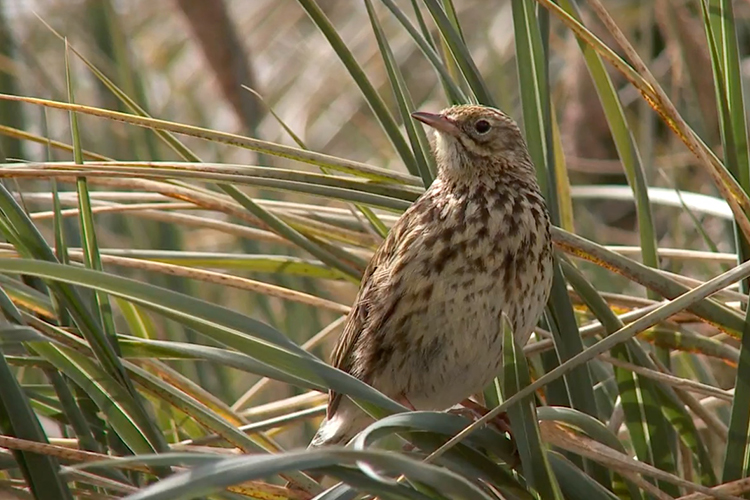South Georgia Pipit Returns to Nest
Posted by Carmin Arnot
in Polar Regions
South Georgia – A Place to Call Home
Wildlife in countless numbers live in and around the isolated island of South Georgia. The surrounding waters of the South Atlantic are extremely rich and productive, providing food for millions of seabirds and marine mammals. The obvious place for this vast number of birds to call home is South Georgia but the arrival of rats, introduced to the island by seafarers over the centuries, had a devastating effect. These bird species had evolved over millions of years to nest on islands and with no trees on South Georgia, all birds must nest on or under the ground. Large seabirds, such as the albatrosses and penguins, are little affected by the presence of rats and mice. But the majority of the smaller bird species fall prey and most of their chicks are killed and eaten. Storm Petrels, Diving Petrels, Prions, Blue Petrels, South Georgia Pintail and the South Georgia Pipit found themselves defenseless against these invasive rodents. Their only hope was for the rats and mice living there to disappear.
South Georgia Habitat Restoration Project
Just six short years ago, South Georgia began the largest rodent eradication project of its kind ever attempted on any island in the world. Led by the South Georgia Heritage Trust (SGHT), their objectives were simple. The monumental Habitat Restoration Project would aim to remove every single rodent from South Georgia and its outlying islands by the year 2015, and working with the Government of South Georgia, ensure that no rodents ever return to the island’s shores. This groundbreaking project will ultimately save native birds, such as the endemic South Georgia Pipit, from extinction and allow millions of seabirds to reclaim their ancestral home after two centuries of domination by rats and mice.
Three Baiting Phases Are Complete
Beginning in 2011, the project team dropped rodent bait in three phases at two-year intervals in all the known rat and mouse infested areas of South Georgia. Helicopters, working from a polar research ship, scattered millions of pellets baited with rodent poison over the glacier-free parts of the island where the rats and mice lived. The unique geography of the island, which is long and thin and intersected by permanent glaciers that prevent the rodents from moving easily between one area and another, ensured that every infested site was treated with bait.
Monitoring Phase and Rat Watch
The monitoring phase of the project (2016-2018) is underway to verify the eradication of all rodents from the island of South Georgia. Phase 4 involves sending teams of people, with trained dogs, to all baited areas to look for any signs of rats and mice. According to Professor Tony Martin, SGHT Habitat Restoration Project Director, the rule of thumb is to investigate two years after baiting is complete. If you don’t find any signs of rodents, you’ve achieved success. Monitoring work has indicated that the Phase 1 baiting of rats was successful. A large survey at the end of 2017 and beginning of 2018 will assess whether the areas baited during Phases 2 and 3 were similarly effective in removing every single rodent. More importantly, teams will also look for the presence of nesting pipits, pintails, petrels, prions and more.
Visitors to South Georgia, including expedition passengers and staff, can take part in this effort as well. Rat Watch was launched so that visitors can participate in identifying and reporting any rodent signs such as tracks in the snow, footprints in the mud, or rat droppings (documented by photographs and GPS readings). Visitors are also encouraged to report spotting or hearing any birdlife that is recovering in the absence of rodents.
South Georgia Pipit Returns
The South Georgia Pipit is likely to be the first bird to respond to the absence of rats and is a great indicator for measuring the project’s success. If the pipit’s song is heard or if young pipits are seen, the rats are sure to have gone. On a December 2016 expedition, Denise Landau, executive director for the Friends of South Georgia Island (FOSGI), watched pipits in aerial display, pipits carrying food and nesting material, and pipits perched on the grass singing exuberantly. “To say it was heart-warming is to massively understate the thrill of realizing that success is within grasp,” she reported. “This tangible evidence suggests that we are on the road to one of the most spectacular restorations imaginable!”
In addition to pipits, South Georgia Pintails are another indicator species that were observed in increased numbers, and Snowy Sheathbills and Snow Petrels were seen to be visibly thriving. Still to be explored are the nesting burrows of the species that visit nocturnally including diving petrels, storm petrels and prions.
Apex Travelers Show Overwhelming Support
On a recent visit to Antarctica and South Georgia, Apex travelers were able to witness first-hand the true glory of South Georgia. Landings ashore revealed what we had been hoping to hear—the joyful singing of South Georgia Pipits across the island! It was during this voyage in January of 2017 that Peter Harrison and Shirley Metz helped raise US$30,250 from fellow travelers inspired by the project’s success and eager to support the cause.
How You Can Help
Friends of South Georgia Island (FOSGI), based in Colorado, is helping to raise the remaining funds needed to complete the final monitoring phase of this significant restoration program. You, too, can help by pledging support. Full details can be found at the FOSGI web site www.fosgi.org. FOSGI is a tax-exempt non-profit organization dedicated to raising funds for the conservation of South Georgia. They can be contacted by email at info@fosgi.org.
See South Georgia with Apex Expeditions
Join Apex in 2018 as we return to the magnificent island of South Georgia on two separate voyages: Antarctica, South Georgia & Falkland Islands and Cape to Cape with South Georgia and Tristan da Cunha Islands.

